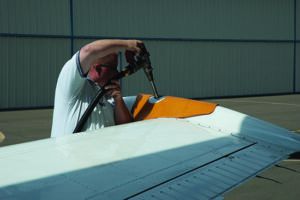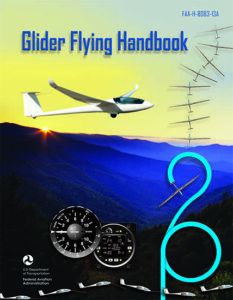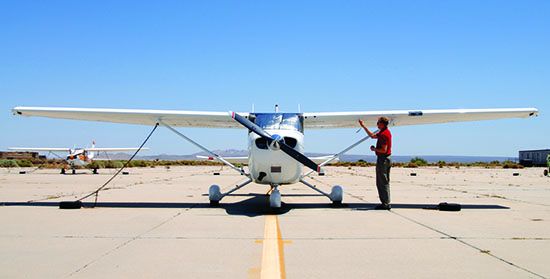My family is moving to a new state soon. Every time we go there to do adult stuff, I carve out a little time to get to know the local flying scene. I had a fun 172 checkout with a CFI at the closest FBO, and have since done some sightseeing flights with friends and relatives. During our last trip there, I picked a convenient afternoon and reserved a Cessna 172 with a plan to visit some local airports. I’d already flown to most of the “big” nearby airports on charters; I wanted to visit the fun places, like where the local EAA chapter meets.
The weather was marginal VFR: Ceilings were a little low, but not bad enough to force scud running. There were some scattered rain showers and visibility was good. This is pretty typical for that area. I didn’t even think there might be a problem.
I hadn’t flown this particular 172 before, so I did a thorough preflight. I couldn’t find the checklist, so I opened the POH to the right pages and set it on the floor by the fuel selector. I probably have well over 1000 hours in Cessna 172s, but I still use the checklist. The Lycoming started right up; I listened to the ATIS, paired my tablet to the ADS-B and started to taxi.
I was more than current. I had flown almost 60 hours in the past 60 days, including five in actual IFR conditions, 14 at night and five instrument approaches. I had flown about eight hours in type in that time, mostly with students. I had a navigation log programmed into my tablet, including the airport diagrams and approach plates for the airports I wanted to visit. It never, ever occurred to me that I might not be ready for this flight. It wouldn’t have occurred to you, either, I’ll bet. Or to an insurance adjuster. But I wasn’t ready.
That’s complacency.

Everyone in aviation is subject to complacency. That includes pilots, controllers, mechanics, fuelers, marshallers and the people processing your fuel payment.
I got scared when an inexperienced fueler waved me away saying, “Don’t worry, I’ve got this.” Fueling errors can be dangerous, and at best the outcome is expensive and smelly. I’ve had several cross-threaded fuel caps in King Airs the past few years. They looked okay on preflight. Fuel streaming from your tank does not look okay. It is not okay to have to explain to your passengers why you are turning back. It’s better to do things right the first time.
So I watched the new guy fuel the airplane. He brought the right truck, he grounded everything properly, he put the fuel into the correct tanks and he put the caps on correctly. But I was worried about his attitude, and for the short time I worked with him (he made too many mistakes and was fired) I watched him every time he fueled my plane, and I warned other pilots to do the same.
DECISION-MAKING
The FAA and training providers have been very good at furnishing pilots with a long list of tools and memory aids designed to improve the aeronautical decision-making (ADM) process. They can be a little dry and sometimes unrealistic, but it’s better to have something to guide you than not.
Take, for example, the PAVE checklist in the Pilot’s Handbook of Aeronautical Knowledge. The acronym’s first letter stands for pilot. Is the PIC ready? The handbook doesn’t mention copilots or first officers or anyone else, although it’s not unusual to have a second pilot on a flight. The second pilot should be ready, too, and everyone’s role should be explicitly understood.
“A” is for aircraft, including performance, limitations and airworthiness. “V” is a bit of stretch, standing for enVironment, meaning things like weather, terrain, airspace and airports. Finally, “E” is for external pressures; “get-there-itis” is a good example.
Another example from the same source is the DECIDE model for ADM. It stands for detect, estimate, change, identify, do, evaluate.
To be honest, I have never used these tools in flight. They strike me as too theoretical, as descriptions made by some professor who has never actually flown an airplane. (Disclaimer: I spent 50 years as a professor, and have known quite a few who have actually flown. But I have had too many colleagues and textbook writers tell me, incorrectly, what pilots do.)
There are some tools I use consistently. To begin with, I ask a lot of “what if?” questions. The acronym IMSAFE is a good tool, standing for illness, medications, stress, alcohol, fatigue and emotion. I use it and I have my students use it.
Once while preparing a glider for a flight with a pre-solo student, a wasp in the equipment shed stung me, near my eye. It felt like I’d been hit by a baseball bat, and the eye was nearly swelled shut by the time we got the glider ready to tow to the flight line. I tried icing the sting but the swelling would not go down. My last flight with this student had been spent, with limited success, teaching him to hold a heading. What if the eye swelled so much that I couldn’t see from it? The student couldn’t even find the glider port, never mind steer us to it, or land the glider. Everyone around said, “Oh, you’ll be fine, let’s launch!” I refused.
When the difficult passengers insisted that I could take them to Aspen, Colo., at night, with no instrument approach, I dodged the stress and emotion and refused.
Some tools aren’t in the FAA literature. Maybe they don’t sound fancy enough. For example, while driving to the airport to fly a multi-engine airplane, I physically rehearse the emergency procedures for an engine failure right after takeoff. A complacent pilot might not do this, but I try not to be a complacent pilot.

Ideas about complacency are scattered throughout FAA and commercially available training materials. The Pilot’s Handbook of Aeronautical Knowledge (FAA-H-8083-25B) mentions “complacency” eight times in the chapter on Aeronautical Decision Making, but several of these are just in passing. Complacency is not one of the five hazardous attitudes (anti-authority, impulsivity, invulnerability, macho and resignation).
The clearest relevant definition I’ve been able to find comes from the Glider Flying Handbook (FAA-H-8083-13A): “Complacency is when a person has a sense of security about one’s surrounding yet fails to recognize or lacks awareness of possible danger.”
COMPLACENCY AND ADM
Except sometimes I am a complacent pilot. Admit it; you are, too.
I took off from what will soon be my home airport in the rented 172, and headed toward my first stop, a towered field 22 nm away. I had actually been there before, not that long ago. The ceiling was a little lower than forecast, but not too low. There was a rain shower along the direct route. I started diverting. The rain shower was moving pretty quickly, so I diverted some more. The route along the Interstate looked pretty clear, and checking the electronic sectional chart showed that the terrain along the interstate was pretty flat.
My tablet flashed to tell me the destination ATIS frequency. What? So soon? Where was I?
“Where am I?” That’s a sure sign of being behind the airplane. I was seven miles out, almost in the Class D airspace. Yup, I was behind. I quickly called the tower and in my best professional pilot voice asked for a straight-in for a touch-and-go landing with a left downwind departure. I was the only airplane around, and the tower operator sounded a little bored. “Approved as requested.”
He may have been bored, but I was not. In this older 172 there was no approach flaps position, so I had to get the airspeed down into the white arc. I was almost too fast and too close. I didn’t want to make a sudden power reduction, so I kept easing back on the throttle and staying a little high to help me slow. I finally got into the white arc on about a one-mile final and put down full flaps. It was, just barely, a stabilized approach.
I actually greased it on at the aim point and started to clean up for the departure. That’s when I noticed the ridge just past the runway. I had never landed here in this direction, and the ridge had never been an issue. Until now. I was already at liftoff speed, or past V1 as we’d say in the turbine world. I started my turn at 400 feet agl, like on an instrument departure.
I never actually got close to the ridge. “Report clear of the Class Delta,” the bored-sounding controller said. Had he even watched?
Now there were more rain showers. I started to turn toward the second airport on my list. “I can always shoot an approach if it gets worse,” I thought. But this was a local sightseeing flight, so I turned back to the airplane’s home base and after dodging some more rain showers, landed and tied the airplane down. My big afternoon of exploring had turned into 0.8 hours of work. Call this my “wake-up flight.”

One big item in the FAA’s IMSAFE risk-management checklist is medications. Some medications are strictly prohibited for pilots, especially if they treat a dangerous underlying condition. Some might cause distractions: For example, the FAA prohibits flight for eight hours after taking Viagra.
You report your current medications on your application for a medical certificate. Once I was surprised to get a letter from the FAA telling me that I couldn’t fly for four hours after taking a medication I had taken for years. I asked my AME about it—when in doubt, ask your AME. She told me there had been cases of debilitating fatigue from this drug. Good call, and good to know.
With other drugs, the FAA and common sense agree that there should be no restriction if a pilot has taken a medication for a long time with no ill effects. How long is long enough? I’ve read that a pilot should wait three to five half-lives after starting a new drug. The half-life is in the drug information from your pharmacist, or you can find it online. For a drug with a 12-hour half-life, the recommendation is to wait 60 hours after you first take it before flying.
HOW COMPLACENCY HURTS
Aviation authorities have given us wonderful decision-making tools: IMSAFE, PAVE, DECIDE, FRAT, and dozens of others. There are books and websites that encourage their use. All of them sound like you are going to print out the form and apply a sharp #2 pencil to determine using a slide rule by what percentage the runway available at your destination exceeds the POH runway requirements, properly adjusted, and whether that percentage falls within your personal limitations, especially on Tuesdays.
Advisory Circular 120-92A, Safety Management Procedures for Aviation Service Providers, sounds like that, with its flow charts and element 2.2 and process 3.3.2 and the like. A large airline might have the resources to translate that into a tool that pilots understand, but most of us cannot even begin to implement these procedures.
I don’t think that’s what people do. “Hey, the runway’s 5000 feet long, and we always get airborne in 1200,'” may well be good enough on a normal day, but increase the weight and the temperature and throw in some headwind-to-tailwind windshear at the departure end and the flight can become very uncomfortable.
That said, “Hey, the runway’s 5000 feet long, and we always get airborne in 1200,'” is much better than doing nothing at all. You have to use these risk-management tools, even if only informally, for them to help you. And that’s where complacency short-circuits all of the material: the complacent pilot doesn’t use the tools.

In addition to the Glider Pilot Handbook, a brochure targeting 12 human factors says complacency is “overconfidence from repeated experience performing a task.” The publication encourages pilots to “avoid the tendency to see what you expect to see.” For example:
- Expect to find errors.
- Don’t sign it if you didn’t do it.
- Use checklists.
- Learn from the mistakes of others.
PROFICIENCY CAN HURT, TOO
Recently I was talking with a helicopter EMS pilot about an upcoming FAA flight check (they operate under FAR Part 135, which requires annual checks). “They want us to do confined area landings,” he told me, “And we do those every day. What a waste.” That’s another form of complacency: overconfidence.
Look back at my experience before my brush with complacency. In the previous two months, I had logged five approaches and five hours of actual IFR; my confidence was high, and I even thought that I would fly an approach if the weather got worse.
But five coupled approaches in a Garmin G1000-equipped King Air isn’t good preparation for a hand-flown approach staring at an unfamiliar steam-gauge panel. At least I had gyros: I’ve lost two friends, both highly IFR-qualified, in separate no-gyro IMC accidents. I wonder if they said, “It will be all right; I’ve flown dozens of approaches.”
Just because you do it all the time does not mean that you don’t need to review, or refresh or learn about new procedures.
INEVITABLE
Another way to look at complacency is that it is inevitable. It will happen to me, it will happen to you, it will happen to the pilot in the next hangar. That sounds like resignation, one of the Five Hazardous Attitudes, but it is recognition, not resignation. Preparation can help a lot when complacency sneaks up on us. On my wake-up flight, the tablet reminding me of the destination ATIS broke the chain, but that only happened because I had programmed it in advance.
It happened to me. It will happen to you. Be ready.
Jim Wolper is an airline transport pilot and retired mathematics professor. He’s also a CFI with single-engine, multi-engine, instrument and glider ratings.




